Learning the friendly way
Dive into our resources, guides, and articles for all things money-related. Grow your financial confidence with our experts curated tips and articles for both experienced and new investors.
LATEST ARTICLEs

Bitcoin, and many other cryptocurrency markets, have seen a phenomenal influx of funds recently, with the overall market cap reaching just shy of $3 trillion. This bullish market presents an advantageous set-up to make money. Trading, while profitable, introduces an array of issues that may be hard for newbies to overcome.
If you are looking to make profits without the added risks then investing may be your best bet. But before you get into investing, there are some basic concepts you will need to grasp in order to make an informed decision. In this article, we're covering how to invest in Bitcoin and cryptocurrencies and what the difference is between investing and trading.
Investing vs Trading
To make a long story short, investing refers to long-term holdings while trading refers to short-term holdings, both are seeking profits within the market.
Generally speaking, investors are after greater returns over a longer period of time while traders seek to draw smaller, more frequent returns from rising and falling markets in a much shorter time frame. Trading thrives off of volatile markets, whereas investing seeks more stable options for longer-term rewards. Both provide the opportunity for profits, but each has benefits and flaws of its own.
For newbies and those who have a more busy lifestyle, investing is the best option as it does not depend on your understanding and monitoring of market movements. Trading on the other hand is more of a career path, it requires considerably more time dedication, while also holding greater risk. As the saying goes, all traders should be investing but not all investors should be trading.
It's important to note that both investing and trading have their own tax regulations and it is on the individual to find out and adhere to these laws. Bank on paying taxes on any returns made, as a general rule of thumb, but always research the guidance information relevant to your jurisdiction, i.e. tax paid on crypto returns will vary from the UK to Germany.
Bitcoin vs Altcoins
Bitcoin, the first cryptocurrency to come into existence, boasts an impressive market cap and is the highest valued cryptocurrency to date. After it launched in 2009, many cryptocurrencies followed suit and were coined "alternative coins" which soon became shortened to altcoins. While these originally focused on payment-centred cryptocurrencies, today the term altcoin essentially refers to any cryptocurrency that isn't Bitcoin.
When it comes to investing and Bitcoin vs altcoins, Bitcoin has proven to be the most valuable coin however there are plenty of small to medium cap markets that experience incredible growth. Consider Bitcoin's large price point to be a hindrance to short term investments, but more powerful in the long run.
To put it into perspective, data shows that if you invested $50,000 into Bitcoin when it was trading around $60,000, you would have to wait for Bitcoin to hit $120,000 before you double your investment. However, if you invested that same $50,000 into an altcoin when it was worth $1, it would only have to reach $2 for you to double your money which is a lot more likely than Bitcoin doubling in the same period. However, this doesn't ring true to all altcoins and one must always do thorough research before investing.
Altcoins come in all different shapes and sizes, some tackling industries from medical to real estate, all backed by the financial aspect of blockchain technology. Investing is about more than just profits, it is also about the project. Is it something you are interested in and could benefit from in the future? Is it something that could change the world for the better? Does it have real-world use cases?
All of these are factors to consider when planning to invest. The potential behind the project is oftentimes what secures it as a viable investment option, promising great opportunity for adoption, stability, and growth. At the end of the day, investing in altcoins requires a considerable amount of research.
Where And How To Invest
The first thing you need to consider is which exchange and wallet you will be using. Long term investments mean you need to find a platform you can trust to store your funds in a longer-term time frame. This is the key to securing your investment, rather than coming back a year or two later to discover your funds are gone.
Some people recommend companies offering hardware wallets to reinforce that investment "do not touch" mindset while others prefer web wallets that are more accessible. It's really up to you which platform you decide you go with, considering all the features and factors, your needs, and confirming your decision with your own research. Make sure to stay up to date on the platform you are storing your funds on to be alerted of any software upgrades, if any hacks occur or if a platform closure notice goes up.
At Tap, we have integrated a hyper-secure wallet into our mobile app, allowing anyone, anywhere to securely store their funds. We are licensed and regulated by the Gibraltar Financial Services Commission and hold insurance of up to $100 million, ensuring the protection of your digital assets at all times. The mobile app also grants users access to a number of cryptocurrency markets, where you can freely buy, sell and manage your portfolio.
Final Thoughts
Investment as a term isn't a difficult concept to catch onto, but finding the right investment is the important part. It is always recommended that you do your own research, and in-depth analysis at that, and don't be scared to diversify your assets. The investment world is yours for the taking, so get out there and start building a lucrative investment portfolio.
FAQ
What is Bitcoin and how does it work?
Bitcoin is arguably this century's greatest innovation: a decentralised digital currency built on blockchain technology that allows for the transfer of value across the internet. This peer-to-peer digital cash system facilitates international payments at a fraction of the cost and time that fiat transactions of that nature take and are as simple as sending an email. Instead of being controlled and managed by banks or government entities, new coins are regularly entered into circulation through the process of mining. You can learn more about Bitcoin, blockchain transparency, and its lack of intermediaries from our guides.
Should I invest in Bitcoin?
As mentioned above, Bitcoin holds great market potential for both investors and traders. Since 2009, Bitcoin has performed well in terms of displaying strong ROIs, something most investors see as a benefit for future gains. However, investing in Bitcoin comes with its own risks that each individual should consider before entering the market. As a rule, never invest more than you are willing to lose.
Which are the three biggest cryptocurrencies?
Currently, based on market cap the three biggest cryptocurrencies are Bitcoin, Ethereum and Tether.
What are the alternatives to Bitcoin?
Alternatives to Bitcoin are referred to as altcoins. While there are thousands of cryptocurrencies on the market, not all are worth investing in. It's best to research each coin individually and weigh up the project before investing in it. Consider a cryptocurrency as a company, and purchasing coins as buying shares in the business.
Disclaimer: This article is intended for communication purposes only, you should not consider any such information, opinions or other material as financial advice. The information herein does not constitute an offer to sell or the solicitation to purchase/invest in any crypto assets and is not to be taken as a recommendation that any particular investment or trading approach is appropriate for any specific person. There is a possibility of risk in investing in crypto assets and investors are exposed to fluctuations in the crypto asset market. This communication should be read in conjunction with Tap's Terms and Conditions.

There are plenty of reports of investors making huge gains in the crypto market over the years, however, there are plenty more ones on people who have lost money. While investing is designed to increase your personal wealth, many investors are often intimidated by the digital currency market due to its volatility and age. In this piece, we're going to run you through the various ways of making money from cryptocurrencies without making a single trade.
After the economies around the world were deeply affected by the Covid-19 pandemic, now is as good a time as any to regain control over your funds and use passive income opportunities as a tool to do so. Tap into the innovation available in the crypto space to pay off your mortgage, bond or leverage your pension and forget about fluctuating market prices.
Passive income 101
The least risky way in which to build your personal wealth is through passive income. Passive income involves generating money from investments that don't require any intervention. This includes activities such as earning dividends from stocks, automated sales through a business, monthly or annual rental from properties, etc.
Another avenue of passive income is earning interest on money in the bank. In this case, the bank will pay you a predetermined percentage of the funds stored in that account. Thankfully, the crypto space has caught up and currently has a number of programs that are offering crypto holders the same benefits, albeit with far greater interest rates. While the regulation surrounding these programs is still being structured, many reliable and trustworthy platforms are offering programs worth taking advantage of.
How to earn passive income with crypto
Below we explore several smart ways in which you can earn a passive income with crypto, all designed to grow your capital. These options are outside of the decentralized finance (DeFi) space so as to avoid any potential problems or scams, rather stick to reliable platforms and networks as outlined below.
Staking
As the crypto space has evolved, many platforms have shifted from the original Proof of Work consensus mechanism to a Proof of Stake one. PoW involves miners competing to solve a complex cryptographic puzzle in order to validate transactions on the network and earn the block reward.
PoS models are less energy-intensive and instead require validators on the network to stake a certain amount of the native cryptocurrency in order to validate the transactions and earn the reward. Anyone can get involved thanks to the likes of PoS platforms like Cardano, Polkadot, and Ethereum 2.0.
Stakers can delegate crypto to a validator and earn a portion of the payouts when the validator completes the process. Requiring very little technical knowledge and minimal capital (each platform is different), staking provides an easy opportunity for a cryptocurrency holder to earn passive income.
Stakes can also opt to be a validator, which requires a considerable amount of effort and technical information. With two options available when it comes to staking, one can either opt to be a validator or delegate coins to a validator. The former will require more capital and attention but yield higher returns, while the latter provides lower returns but ensures that the validators do all the work.
Mining
On the other side of the coin, there is mining. Mining is native to PoW networks and involves confirming transactions for a reward. Networks vary in terms of what computer resources one might need, although cheap electricity is essential as these machines typically require large amounts of power.
The world of mining has progressed in leaps and bounds since the early days of using CPUs to mine Bitcoin. Should one want to explore this path, we advise you do extensive research on the cost implications beforehand.
Lending
A method favoured by long term investors looking to earn interest on their already accumulated crypto assets, lending involves borrowing the funds to a platform in return for interest. These funds are typically locked away for a certain period of time in exchange for interest payments later on.
Peer-to-peer (P2P) lending platforms usually have a fixed or variable interest rate and will handle the logistics of the borrower and lender. These types of services are often found on platforms that offer margin trading.
Make money without engaging in any trades, with no betting on the outcome of the market. Passive income from cryptocurrencies can be done simply by storing your already accumulated digital currencies in an income-generating account. Experiences on various platforms will vary, however, in most cases the customer will deposit their funds into a specific account and earn interest in the same currency. Check the platform's publication for guidance if you need any assistance.
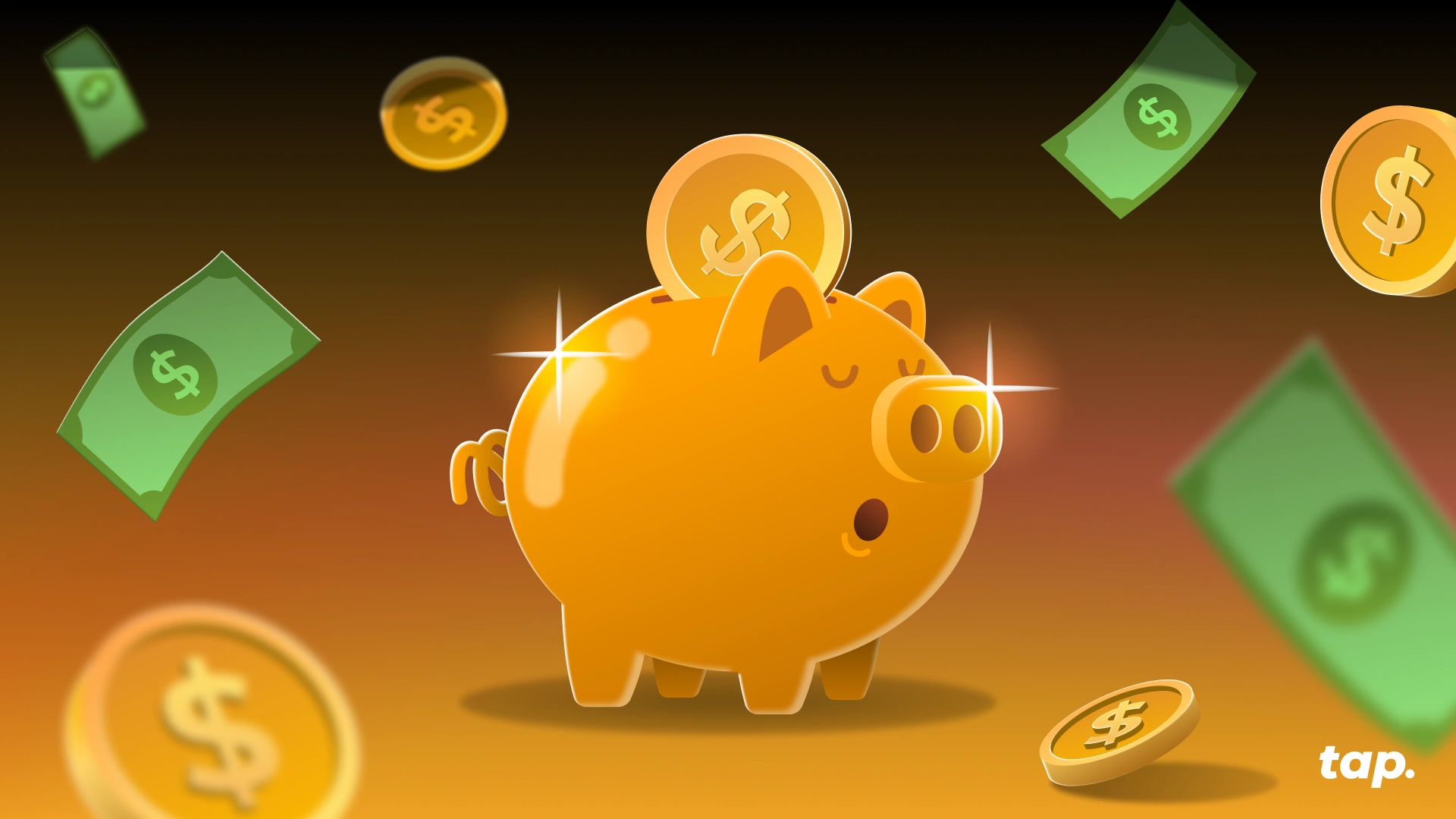
With rising inflation rates and economic downturns around the world, there's plenty of speculation that we're headed for another global recession. While the media tends to paint the darkest picture, it's always worth being prepared. In this article we're providing five action points you can do now to ensure that your finances remain recession-proof.
The National Bureau of Economic Research defines a recession as “a significant decline in economic activity that is spread across the economy and that lasts more than a few months. It's worth noting that these are a natural part of the economic cycle and are completely unavoidable. The best thing you can do is be educated and prepared with a reliable plan in place to overcome any economic downturn.
According to a study conducted by Empower and Personal Capital, 74% of consumers in the U.S. are concerned over an impending recession. While some analysts believe the recession has already started, Goldman Sachs has predicted there is a 30% chance of one materializing while UBS has forecast "no recession".
Whichever side of the fence you sit on, it can't hurt to be prepared. While it sounds dark and gloomy, we're here to help you prepare for a recession.
Anxious about an incoming recession?
Here are 5 steps to get yourself recession ready
1. Try to eradicate debt
The first step of most financial plans, paying off high-interest debt is a valuable practice. The recent increase in interest rates by the Federal Reserve has seen credit card rates rise over 17% for the first time in two years. Analysts are predicting that these interest rates will continue to rise in the coming months. Avoid credit card debt and the high-interest rates associated with them.
If you are carrying high-interest-rate debt, your best port of call would be to strategically manage this, with the intention to pay it off as soon as possible. With recessions oftentimes come job cuts, and if this happens to you paying off your debt now will be a worthy exercise. Known that in times of recession, interest rates will increase.
2. Lessen your expenses
Consider your monthly living expenses and what you spend money on and see where you can make cuts in order to prepare for the "worst case scenario". Consider what would happen if you were to receive a lower salary, if you were to lose your job, or if you were suddenly faced with an emergency (more on emergency savings next).
While these can take place at any stage, having a plan will help you to be prepared should you come face to face with this. Monitoring your monthly expenses is, either way, a great opportunity to stay on top of your finances and improve your financial situation.
3. Establish your emergency savings fund (and bulk it up)
If you haven't already done so, establish an emergency fund. Financial advisors define an emergency fund as three to six months' worth of living expenses. This emergency fund is to be used for unexpected expenses like home repairs, a car issue, a medical emergency etc. This is separate from your retirement account, and acts as a cash cushion should you need it.
As you prepare for a recession, it's advised to bulk up your emergency fund to be at least six months' worth of expenses/salary. This personal budget will act as your financial safety net should you need it, a rainy day fund. For bonus points, try to keep this in interest-generating savings accounts.
4. Update your resume
In the unfortunate event of losing your job in a recession, it will bode well to build your resume up before the time so that you can immediately start searching for a new job. During recessions, the job-seeking market tends not to favor job seekers so being prepared beforehand may work out to be to your advantage.
Alternatively, if you were considering advancing your education or going back to school, this could be a prime time to do so. This will not only improve your chances of employment in the future but also allow you time to emerge when the job market is more favorable.
5. Stick to long-term investment plans
In times of recessions it might seem tempting to cut back on retirement savings or pull investments, but try to hold strong. These investments are for the long term and will lose significant value if pulled prematurely, especially in the crypto and stock market.
Focus on managing your emotions and consider the long-term benefits. After the recession moves into its next economic phase would you rather have your long-term investment in place, or have to start again? Especially if your investments are linked to a retirement portfolio. For ease of mind, know that historical data proves that a bull market lasts longer than a bear market.
Whether you're invested in crypto, gold, or the stock market, stick to your long-term strategy and don't be tempted to make decisions based on fear, they rarely turn out to be good ones.
Closing thoughts on surviving economic downturn
Recessions tend to carry a lot of fear mongering news, however, did you know that the recession in 2020 only lasted for two months? While they're times of little to no economic growth, they are just as quickly corrected and allow new innovations, services, and economic activity to ignite. Consider it a breeding ground for new opportunities.
Use the time beforehand to prepare for a recession by managing your expenses, freeing yourself from high-interest rates, and building an appropriate savings account to see you through. If in doubt, consider speaking to a financial advisor who can professionally guide you in building a solid financial plan.
Disclaimer: This article is intended for communication purposes only, you should not consider any such information, opinions or other material as financial advice. This communication should be read in conjunction with Tap’s Terms and Conditions.

Ever wondered if you're winning or losing the money game? Your net worth holds the answer - and it's easier to calculate than you think.
What is net worth? (and why should you care?)
Think of net worth as your financial report card. It's the ultimate measure of your financial health - not how much you earn, but how much you're actually worth.
Here's the simple truth: net worth = what you own - what you owe
Unlike your salary (which just shows your monthly income), net worth gives you the big picture. It's like comparing a snapshot to a full movie of your financial life.
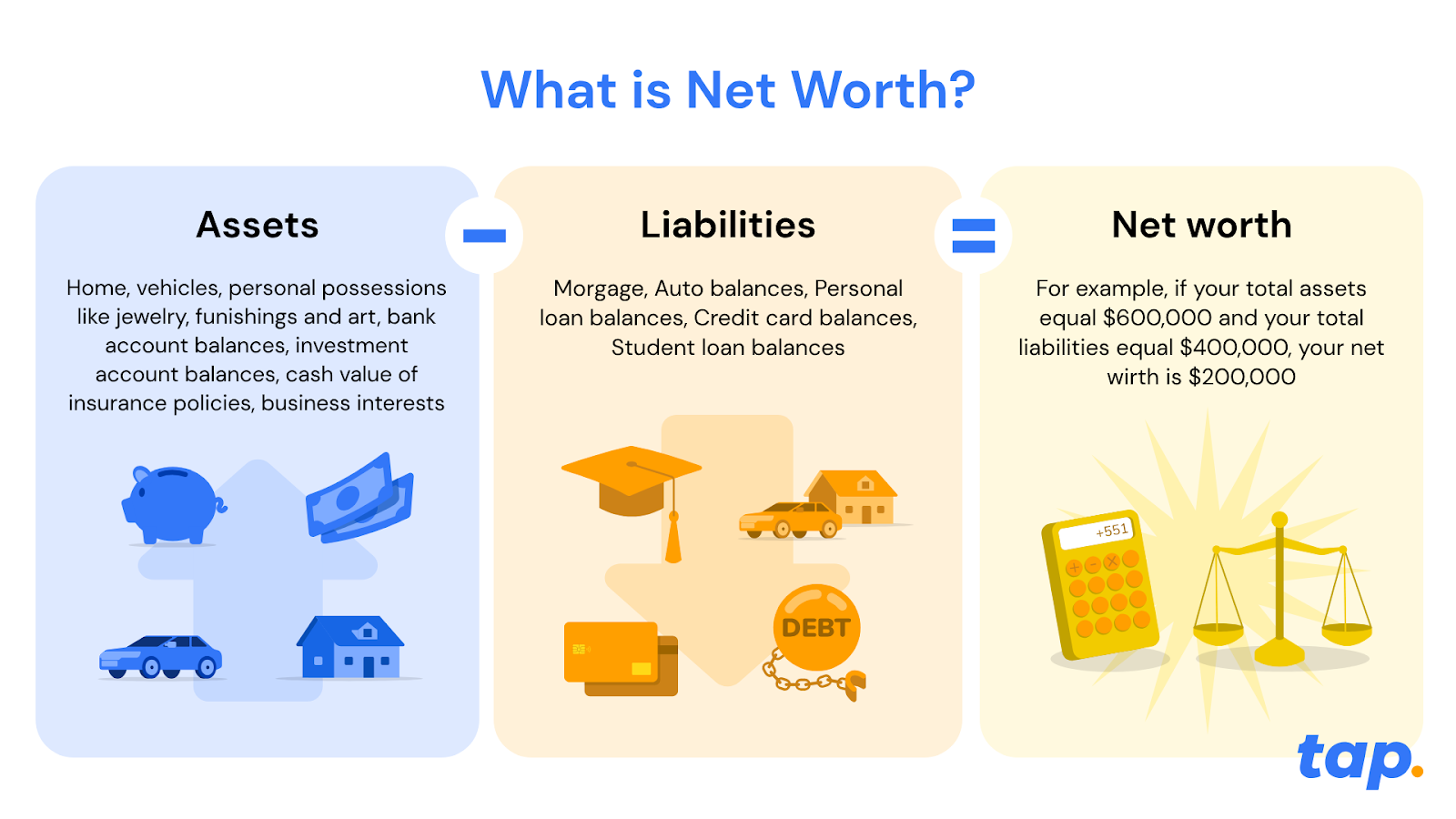
Why net worth beats income every time
You might earn $100,000 a year, but if you owe $150,000 in debt with only $20,000 in assets, your net worth is actually negative $130,000. Meanwhile, someone earning $50,000 with $200,000 in assets and $50,000 in debt has a net worth of $150,000. Who's really ahead?
The net worth formula
Assets (the good stuff you own)
- Real Estate: Your home, investment properties, land
- Investments: Stocks, bonds, mutual funds, crypto
- Retirement accounts: pension funds
- Cash & savings: Bank accounts, CDs, money market accounts
- Valuable possessions: Cars, jewellery, art, collectables
- Business interests: Ownership stakes, equipment
Liabilities (what's draining your wealth)
- Mortgages: Home loans, investment property loans
- Student loans: Education debt
- Credit cards: Outstanding balances
- Auto loans: Car payments
- Personal loans: Any other borrowed money
- Outstanding bills: Medical debt, taxes owed
How to calculate your net worth (3 simple steps)
Step 1: List your assets
Add up everything valuable you own. Be honest but don't undervalue quality items.
Step 2: Total your liabilities
List every debt, loan, and outstanding balance. Yes, even that store credit card.
Step 3: Do the maths
Assets - liabilities = your net worth
Real-world examples: Meet Sarah and Mark
Sarah's success story
Assets:
- Home: $400,000
- Savings: $50,000
- Investment Portfolio: $150,000
- 401(k): $200,000
- Vehicle: $20,000
- Total Assets: $820,000
Liabilities:
- Mortgage: $200,000
- Student Loan: $30,000
- Total Liabilities: $230,000
Sarah's net worth: $590,000
Sarah's doing great! Her assets significantly outweigh her debts.
Mark's comeback journey
Assets:
- Car: $10,000
- Personal Items: $5,000
- Total Assets: $15,000
Liabilities:
- Student Loans: $50,000
- Credit Cards: $8,000
- Medical Bills: $3,000
- Total Liabilities: $61,000
Mark's net worth: -$46,000
Mark has negative net worth, but this is his starting point, not his destiny.
6 reasons why it’s beneficial to grow your net worth
Financial security
Increasing your net worth provides a foundation of financial security. As your net worth grows, you have a greater buffer against unexpected expenses, job loss, or economic downturns. It offers a safety net to navigate through challenging times and helps you maintain stability in your financial life.
Achieving financial goals
A higher net worth enables you to achieve your financial goals and aspirations. Whether it's buying a home, starting a business, funding education, or retiring comfortably, a growing net worth provides the necessary resources and financial freedom to pursue your dreams.
Building wealth
Net worth is a measure of your wealth accumulation over time. By actively growing your net worth, you increase your overall wealth and improve your financial position. It allows you to build a stronger foundation for yourself and potentially leave a legacy for future generations.
Better financial opportunities
A higher net worth opens doors to better financial opportunities. It improves your borrowing capacity, allowing you to secure favourable loan terms and interest rates when needed. Additionally, a strong net worth can attract investment opportunities and partnerships that can further boost your wealth.
Flexibility and choices
Increasing your net worth provides you with more flexibility and choices in life. It affords you the freedom to make decisions based on what aligns with your long-term goals and values, rather than being constrained by financial limitations. A growing net worth expands your options and empowers you to take calculated risks or make life-changing decisions with confidence.
Peace of mind
Knowing that your net worth is growing can bring peace of mind. It reduces financial stress and anxiety, allowing you to focus on other aspects of your life. A positive net worth provides a sense of control over your financial well-being and offers peace of mind that you are on the right track towards a secure financial future.
Tips for increasing your net worth
Boost your income
- Level up your career: Ask for raises, pursue promotions, learn high-value skills
- Create side hustles: Freelancing, online businesses, passive income streams
- Invest in yourself: Education and skills that increase your earning power
Supercharge your assets
- Diversify smartly: Don't put all eggs in one basket
- Think long-term: Focus on assets that appreciate over time
- Get professional help: Financial advisors can spot opportunities you might miss
- Review regularly: Markets change - your strategy should too
Crush your debt
- Target high-interest debt first: Credit cards are wealth killers
- Consider consolidation: Lower interest rates = more money for you
- Create a payoff plan: Set deadlines and stick to them
- Avoid new debt: Unless it's for appreciating assets
Master the long game
- Emergency fund: 3-6 months of expenses (minimum!)
- Retirement planning: Start early, contribute consistently
- Professional guidance: Sometimes paying for advice saves you thousands
- Track progress: What gets measured gets improved
The bottom line: your financial transformation starts now
Your net worth isn't just a number; it's your financial GPS, showing exactly where you stand and where you're headed. Whether you're starting with negative net worth like Mark or building on a solid foundation like Sarah, the principles remain the same.
Remember: Every financial giant started with a single step. Your current net worth is just your starting line, not your finish line.
Start tracking your net worth today, and watch as this simple practice transforms not just your bank account, but your entire relationship with money. Your future self will thank you!
Ready to take control of your financial destiny? Calculate your net worth this week and set your first wealth-building goal. The journey to financial freedom starts with knowing where you stand.
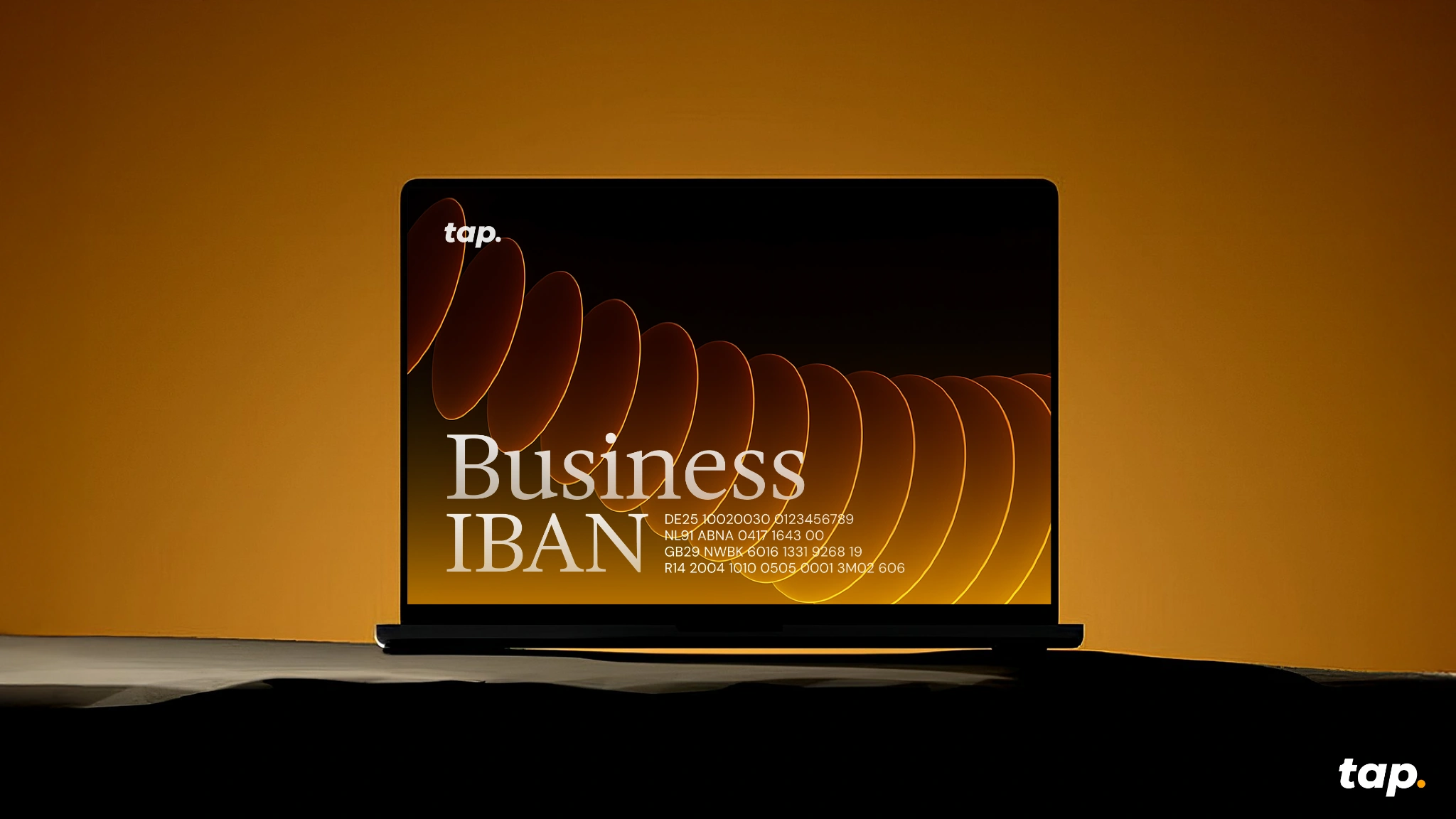
Managing payments across borders remains one of the biggest operational challenges for expanding businesses. While digital transformation has touched nearly every aspect of commerce, international banking is currently lagging behind with separate systems for crypto and traditional currency transactions, creating unnecessary complexity.
Tap solves this problem by offering each business a multi-currency account with a dedicated IBAN that functions as a bridge between these two financial worlds. For businesses handling both crypto and fiat currencies, this means one unified system rather than juggling multiple accounts and conversion processes. This isn't just convenient - it directly impacts your bottom line by reducing transaction fees, speeding up settlements, and simplifying reconciliation.
If you're handling international payments or considering crypto adoption, this could significantly streamline your financial operations. Here's what you need to know.
What is a business IBAN?
An IBAN (International Bank Account Number) serves as your business's financial passport - a standardised identifier recognised across 78+ countries. Unlike traditional account numbers, a Business IBAN follows a structured format that includes country codes, bank identifiers, and your unique account number.
What sets Tap's approach apart is the integration of this established banking standard with crypto functionality. Instead of operating in parallel financial universes, your transactions (whether in euros, dollars, or Bitcoin) flow through a single identifiable channel.
For finance teams, this means the end of reconciliation nightmares. For your customers and partners, it means one consistent payment destination regardless of their preferred currency.
How Business IBANs Work
The mechanics behind modern business transactions
A Business IBAN functions as the digital coordinates for your company's financial location in the global banking ecosystem. When properly implemented, it creates a frictionless path for money to flow into and out of your business regardless of currency type or originating country.
Sending and receiving payments
When receiving payments, your Business IBAN acts as a universal identifier that works across different payment systems. Clients simply enter your IBAN (and sometimes BIC code) into their banking platform, eliminating the confusion of different account number formats across countries.
For outgoing payments, the process works in reverse. You provide the recipient's IBAN, specify the amount, and Tap's platform handles the routing complexities behind the scenes. This standardisation prevents the common errors that lead to payment delays and rejection fees.
What separates Tap's system from conventional banking is the integration layer that works with both crypto and traditional currencies. When a client pays in Bitcoin, for example, you can choose to receive it as cryptocurrency or have it automatically converted to your preferred fiat currency before it reaches your account.
Banking networks demystified
Business IBANs interact with several key payment networks:
SEPA (Single Euro Payments Area): Covering 36 European countries, SEPA processes euro-denominated transfers typically within one business day at low fixed costs. Your Business IBAN automatically routes euro payments through this network without requiring a separate setup.
SWIFT (Society for Worldwide Interbank Financial Telecommunication): The backbone of international banking, SWIFT connects over 11,000 financial institutions worldwide.
Real-world transaction example
Consider a UK-based e-commerce business receiving payment from a German customer:
- The customer initiates a €5,000 payment to the merchant's business IBAN
- The transaction enters the SEPA network and arrives in the merchant's Tap account within hours
- The merchant can either keep the funds in euros or convert to GBP at their preferred timing
- If choosing to convert, Tap executes the exchange at market rates with minimal spread
- The funds become available for business operations, supplier payments, or withdrawal
This same process that once required multiple accounts, banking relationships, and days of processing now happens automatically through a single business IBAN. For businesses managing dozens or hundreds of such transactions monthly, the efficiency gains and cost savings compound significantly.
The ability to handle these complex financial pathways through one unified system represents the core value proposition of modern business IBANs - simplicity on the surface, sophisticated routing underneath.
Cross-border advantages that impact your bottom line
The practical benefits of a business IBAN become immediately apparent in cross-border transactions:
- Reduced rejection rates: correctly formatted IBANs virtually eliminate payment failures due to incorrect account details
- Faster settlement times: direct routing through the SEPA network for European transactions
- Lower transaction costs: fewer intermediaries means fewer fees eating into your margins
- Simplified compliance: clearer transaction trails for more straightforward reporting
Bridging crypto and traditional finance
The crypto market now represents a $2 trillion opportunity that many businesses struggle to tap into due to technical and operational barriers. A business account with Tap eliminates these obstacles by providing:
- Seamless conversion between crypto and fiat currencies
- Consolidated financial reporting across all currency types
- Regulatory compliance built into the platform
- Reduced exposure to crypto volatility through instant conversion options
For businesses cautiously exploring crypto acceptance, this hybrid approach offers a low-risk entry point without requiring major infrastructure changes.
Implementation without disruption
Setting up a business account through Tap requires minimal operational changes:
- Fill in the contact form to initiate a callback
- Complete the business account set-up and verification process
- Receive your unique account with IBAN
- Update payment details with clients and suppliers
- Integrate with your existing accounting systems
The entire process typically takes less than 48 hours, with Tap's team handling the technical heavy lifting.
Is a Tap business account right for your growth strategy?
It's worth considering a business account if your company:
- Operates in multiple countries or currencies
- Needs to reduce payment processing costs
- Wants to accept crypto payments without complexity
- Are looking to streamline financial operations
As payment landscapes continue evolving, businesses that implement flexible, future-proof solutions gain a significant competitive advantage in customer experience and operational efficiency.
Explore how a business IBAN could fit into your financial infrastructure by visiting Tap's business solutions page, from where a dedicated account manager can discuss potential savings based on your specific transaction patterns.
The business world won't wait for outdated payment systems to catch up. The question isn't whether you need more efficient payment solutions - it's how quickly you can implement them.
Let’s make your cross-border payments simple. Schedule a chat with our expert team and explore how Tap can work for your business.

The crypto market just pulled off one of its boldest recoveries in recent memory. What began as a violent sell-off on October 10 has given way to a surprisingly strong rebound. In this piece, we’ll dig into “The Great Recovery” of the crypto market, how Bitcoin’s resilience particularly stands out in this comeback, and what to expect next…
The Crash That Shook It All
On October 10, markets were rattled across the board. Bitcoin fell from around $122,000 down to near $109,000 in a matter of hours. Ethereum dropped into the $3,600 to $3,700 range. The sudden collapse triggered massive liquidations, nearly $19 billion across assets, with $16.7B in long positions wiped out.
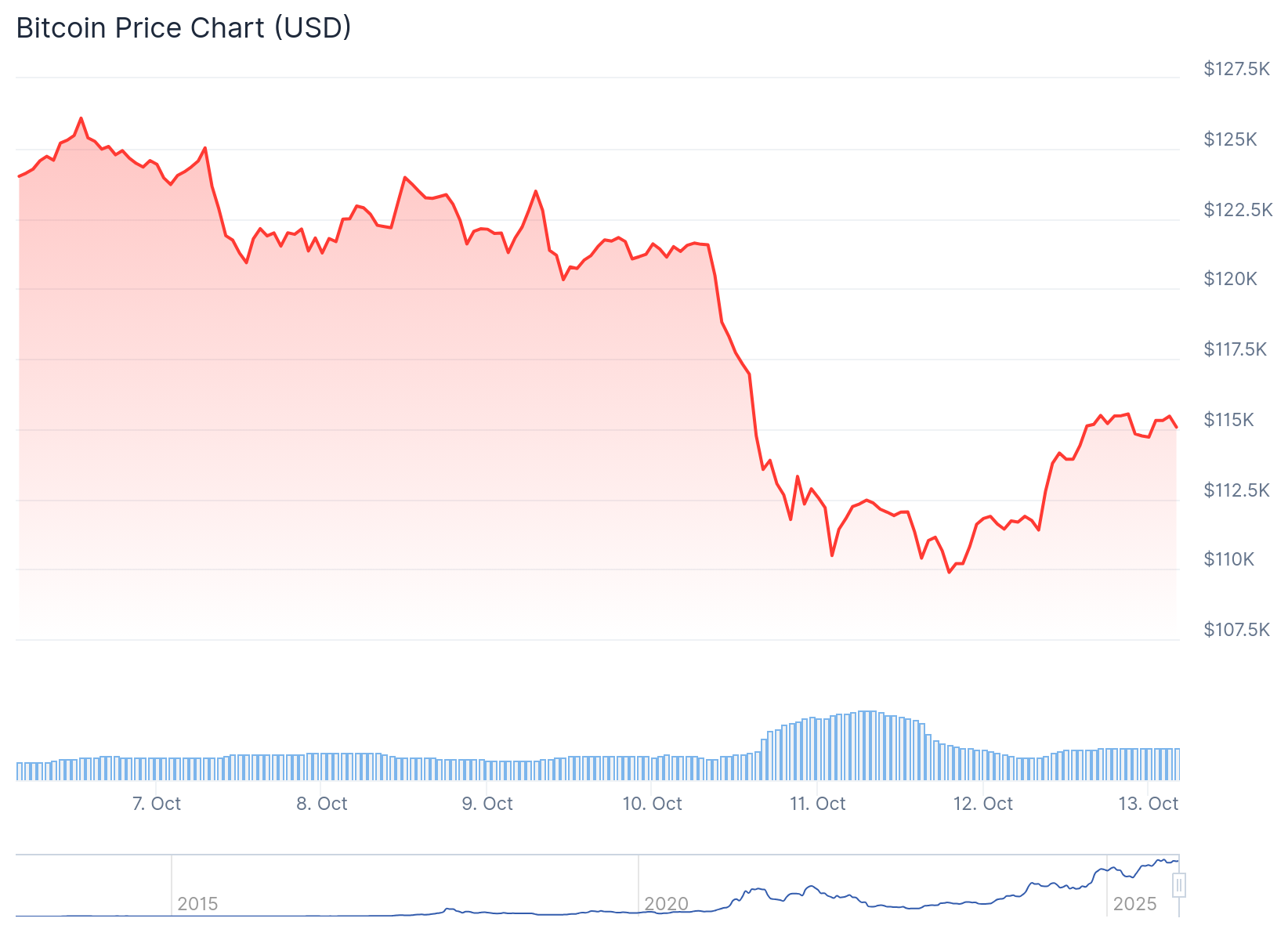
That kind of forced selling, often magnified by leverage and thin liquidity, created a sharp vacuum. Some call it a “flash crash”; an overreaction to geopolitical news, margin stress, and cascading liquidations.
What’s remarkable, however, is how quickly the market recovered.
The Great Recovery: Scope and Speed
Within days, many major cryptocurrencies recouped large parts of their losses. Bitcoin climbed back above $115,000, and Ethereum surged more than 8%, reclaiming the $4,100 level and beyond. Altcoins like Cardano and Dogecoin led some of the strongest rebounds.
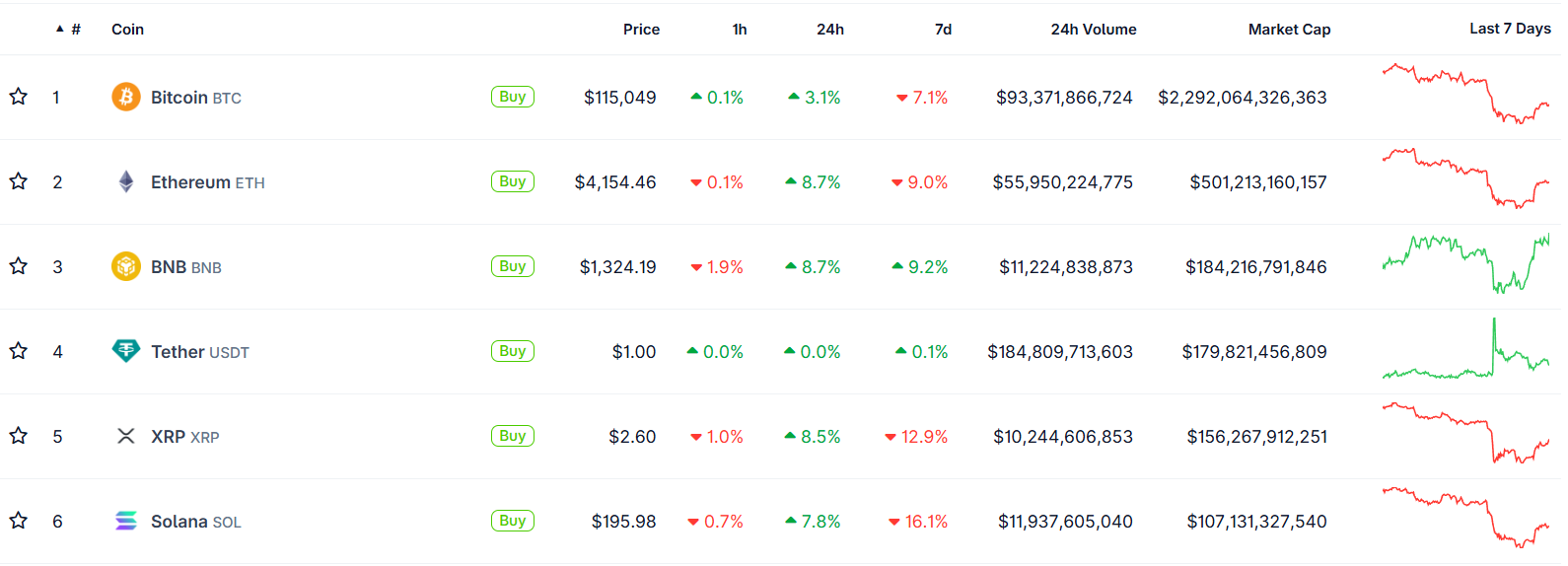
One narrative gaining traction is that this crash was not a structural breakdown but a “relief rally”, a market reset after overleveraged participants were squeezed out of positions. Analysts highlight that sell pressure has eased, sentiment is stabilizing, and capital is re-entering the market, all signs that the broader uptrend may still be intact.
“What we just saw was a massive emotional reset,” Head of Partnerships at Arctic Digital Justin d’Anethan said.

“I would have another, more positive take: seeing 10B worth of liquidation happen in a flash and pushing BTC prices down 15%+ in less than 24hrs to then see BTC recoup 10% to 110K is a testament to how far we've come and how massive and important BTC has become,” he posted on 𝕏.
Moreover, an important datapoint stands out. Exchange inflows to BTC have shrunk, signaling that fewer holders are moving coins to exchanges for sale. This signals that fewer investors are transferring their Bitcoin from personal wallets to exchanges, which is a common precursor to selling. In layman terms, coins are being held rather than prepared for trade.
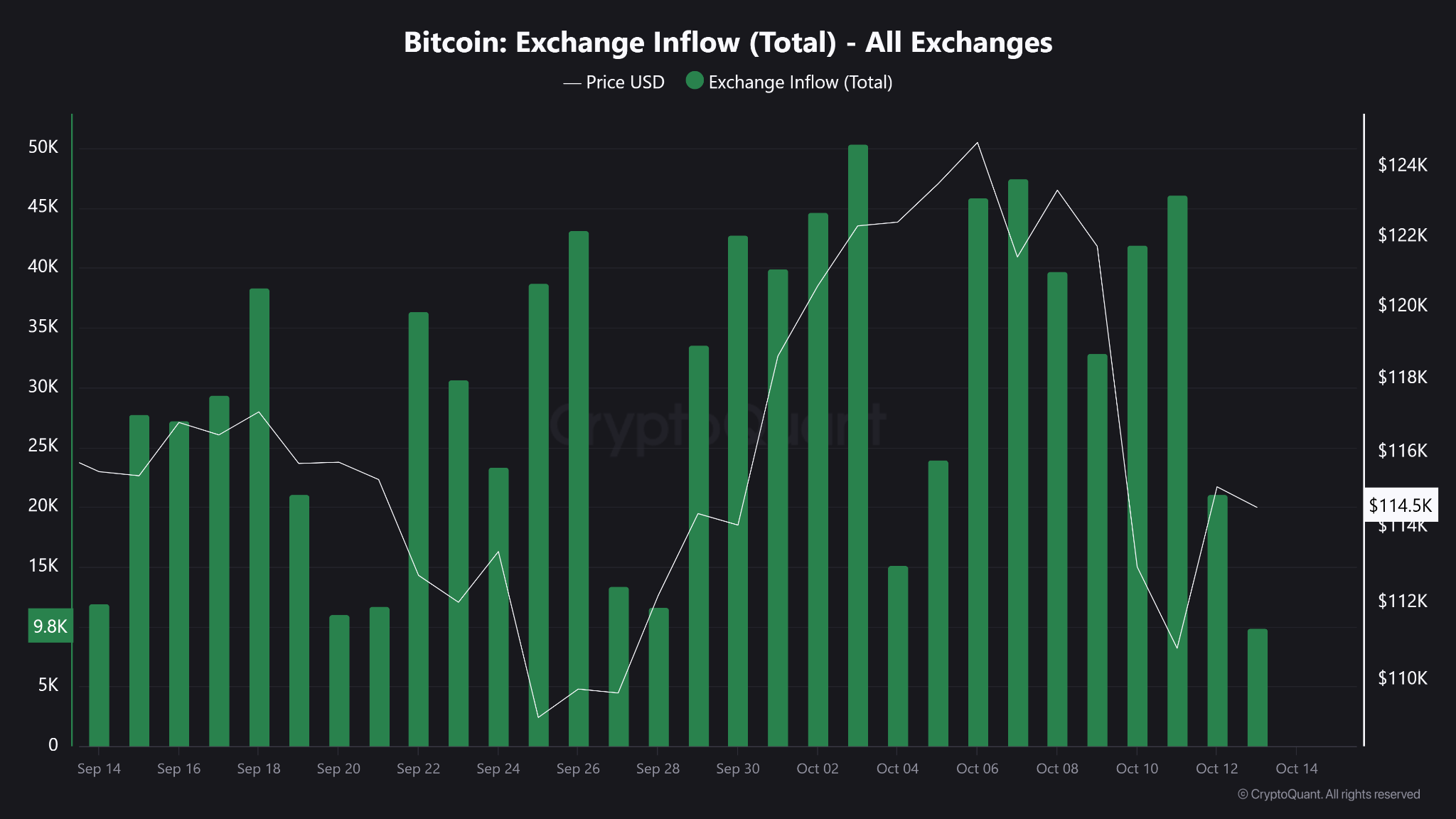
Bitcoin’s Backbone: Resilience Under Pressure
Bitcoin’s ability to rebound after extreme volatility has long been one of its defining traits. Friday’s drop admittedly sent shockwaves through the market, triggering billions in liquidations and exposing the fragility of leveraged trading.
Yet, as history has shown, such sharp pullbacks are far from new for the world’s largest cryptocurrency. In its short history, Bitcoin has endured dozens of drawdowns exceeding 10% in a single day (from the infamous “COVID crash” of 2020 to the FTX collapse in 2022) only to recover and set new highs months later.
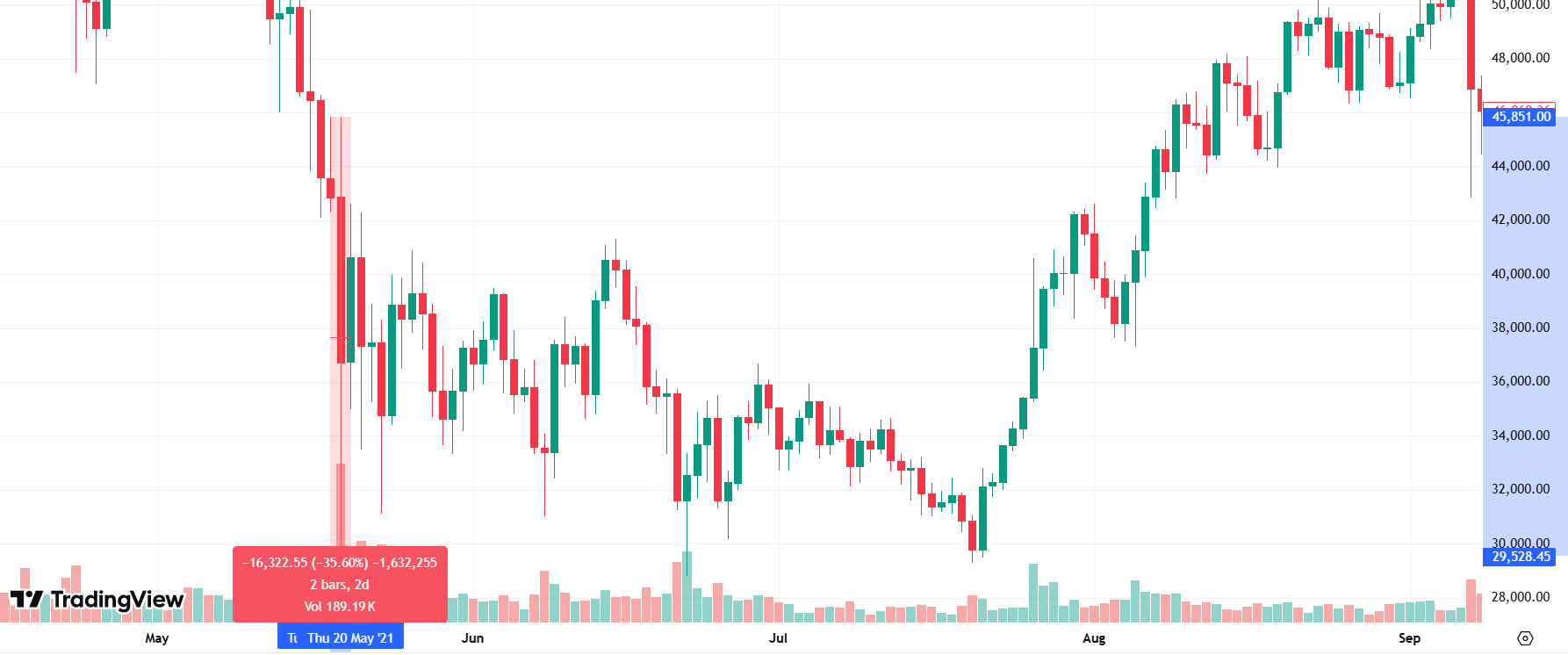
This latest event, while painful, highlights a maturing market structure. Since the approval of spot Bitcoin ETFs in early 2024, institutional involvement has deepened, creating greater liquidity buffers and stronger institutional confidence. Even as billions in leveraged positions were wiped out, Bitcoin has held firm around the $110,000 zone, a level that has since acted as psychological support.
What to Watch Next
The key question now is whether this rebound marks a short-term relief rally or the start of a renewed uptrend. Analysts are closely watching derivatives funding rates, on-chain flows, and ETF inflows for clues. A sustained increase in ETF demand could provide a steady bid under the market, offsetting the effects of future liquidation cascades. Meanwhile, Bitcoin’s ability to hold above $110,000 (an area of heavy trading volume) may serve as confirmation that investor confidence remains intact.
As the market digests the events of October 10, one lesson stands out. Bitcoin’s recovery isn’t just a matter of luck, it’s a reflection of underlying market structure that can absorb shocks. It is built on a growing base of long-term holders, institutional adoption, and a financial system increasingly intertwined with digital assets. Corrections, however dramatic, are not signs of weakness; they are reminders of a maturing market that is striding towards equilibrium.
Bottom Line
The crash on October 10 was brutal, there’s no denying that. It was one of the deepest and fastest in recent memory. But the recovery has been equally sharp. Rather than exposing faults, the rebound has underscored the market’s adaptability and Bitcoin’s central role.
The market consensus is seemingly leaning towards a reset; not a reversal. The shakeout purged excess leverage, and the comeback underlined demand. If Bitcoin can maintain that strength, and the broader market keeps its footing in the coming days, this could mark a turning point rather than a cave-in.
TAP'S NEWS AND UPDATES
What’s a Rich Text element?
What’s a Rich Text element?The rich text element allows you to create and format headings, paragraphs, blockquotes, images, and video all in one place instead of having to add and format them individually. Just double-click and easily create content.
The rich text element allows you to create and format headings, paragraphs, blockquotes, images, and video all in one place instead of having to add and format them individually. Just double-click and easily create content.Static and dynamic content editing
Static and dynamic content editingA rich text element can be used with static or dynamic content. For static content, just drop it into any page and begin editing. For dynamic content, add a rich text field to any collection and then connect a rich text element to that field in the settings panel. Voila!
A rich text element can be used with static or dynamic content. For static content, just drop it into any page and begin editing. For dynamic content, add a rich text field to any collection and then connect a rich text element to that field in the settings panel. Voila!How to customize formatting for each rich text
How to customize formatting for each rich textHeadings, paragraphs, blockquotes, figures, images, and figure captions can all be styled after a class is added to the rich text element using the "When inside of" nested selector system.
Headings, paragraphs, blockquotes, figures, images, and figure captions can all be styled after a class is added to the rich text element using the "When inside of" nested selector system.What’s a Rich Text element?
What’s a Rich Text element?The rich text element allows you to create and format headings, paragraphs, blockquotes, images, and video all in one place instead of having to add and format them individually. Just double-click and easily create content.
The rich text element allows you to create and format headings, paragraphs, blockquotes, images, and video all in one place instead of having to add and format them individually. Just double-click and easily create content.Static and dynamic content editing
Static and dynamic content editingA rich text element can be used with static or dynamic content. For static content, just drop it into any page and begin editing. For dynamic content, add a rich text field to any collection and then connect a rich text element to that field in the settings panel. Voila!
A rich text element can be used with static or dynamic content. For static content, just drop it into any page and begin editing. For dynamic content, add a rich text field to any collection and then connect a rich text element to that field in the settings panel. Voila!How to customize formatting for each rich text
How to customize formatting for each rich textHeadings, paragraphs, blockquotes, figures, images, and figure captions can all be styled after a class is added to the rich text element using the "When inside of" nested selector system.
Headings, paragraphs, blockquotes, figures, images, and figure captions can all be styled after a class is added to the rich text element using the "When inside of" nested selector system.What’s a Rich Text element?
What’s a Rich Text element?The rich text element allows you to create and format headings, paragraphs, blockquotes, images, and video all in one place instead of having to add and format them individually. Just double-click and easily create content.
The rich text element allows you to create and format headings, paragraphs, blockquotes, images, and video all in one place instead of having to add and format them individually. Just double-click and easily create content.Static and dynamic content editing
Static and dynamic content editingA rich text element can be used with static or dynamic content. For static content, just drop it into any page and begin editing. For dynamic content, add a rich text field to any collection and then connect a rich text element to that field in the settings panel. Voila!
A rich text element can be used with static or dynamic content. For static content, just drop it into any page and begin editing. For dynamic content, add a rich text field to any collection and then connect a rich text element to that field in the settings panel. Voila!How to customize formatting for each rich text
How to customize formatting for each rich textHeadings, paragraphs, blockquotes, figures, images, and figure captions can all be styled after a class is added to the rich text element using the "When inside of" nested selector system.
Headings, paragraphs, blockquotes, figures, images, and figure captions can all be styled after a class is added to the rich text element using the "When inside of" nested selector system.What’s a Rich Text element?
What’s a Rich Text element?The rich text element allows you to create and format headings, paragraphs, blockquotes, images, and video all in one place instead of having to add and format them individually. Just double-click and easily create content.
The rich text element allows you to create and format headings, paragraphs, blockquotes, images, and video all in one place instead of having to add and format them individually. Just double-click and easily create content.Static and dynamic content editing
Static and dynamic content editingA rich text element can be used with static or dynamic content. For static content, just drop it into any page and begin editing. For dynamic content, add a rich text field to any collection and then connect a rich text element to that field in the settings panel. Voila!
A rich text element can be used with static or dynamic content. For static content, just drop it into any page and begin editing. For dynamic content, add a rich text field to any collection and then connect a rich text element to that field in the settings panel. Voila!How to customize formatting for each rich text
How to customize formatting for each rich textHeadings, paragraphs, blockquotes, figures, images, and figure captions can all be styled after a class is added to the rich text element using the "When inside of" nested selector system.
Headings, paragraphs, blockquotes, figures, images, and figure captions can all be styled after a class is added to the rich text element using the "When inside of" nested selector system.Kickstart your financial journey
Ready to take the first step? Join forward-thinking traders and savvy money users. Unlock new possibilities and start your path to success today.
Get started



.webp)







.webp)